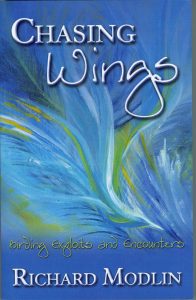 |
|
| ABOUT CHASING WINGS
Birds remind us that we share the planet with other creatures. They are colorful, energetic and fascinating, and they bring joy, contentment and wonder to those who follow them. Bird watching has become a pastime enjoyed by 46 million people in our country. Chasing Wings is an account of one person’s passion. In twenty-four chapters Richard Modlin vividly relates his humorous encounters with birds and lucidly describes his travels to exotic and routine birding locations. The book begins with a child’s account of picking up a baby blue jay, then quickly being aggressively confronted by its parents. A few years later the author attempts to make a pet of a juvenile American kestrel, only to learn that raptors like freedom. Modlin writes of other novel avian interactions in his life. For instance, on an island off Belize, Central America, a magnificent frigatebird became a common visitor to collect handouts and relax on arms and shoulder of visiting researchers. On a boat ramp in Connecticut, an adult mute swam got revenge. Then there was the cold evening when Modlin found that a trio of starling had invaded his attic apartment Years later and in another state, he found that excited starling were easier to handle than the three wild turkeys that tried to beat their way into his sunroom. Modlin’s account of saving a pied-billed grebe chick from the jaws of a northern pike, then spending the summer raising it and returning it to the wild, is heartwarming. A trip to West Sister Island, Lake Erie, the author realized what the impact a 200-fold increase of double-crested cormorants in eleven years can have on a fragile habitat. Travel with the author to view widowbirds, ostriches, sunbirds, parrots, toucans, blue pigeons, paradise flycatchers, hummingbirds and other exotic birds as he describes his visits to Kenya, Seychelle Islands, Grand Cayman Island and the rain forests of Belize. In France he visited a raptor aviary and searched the forests of Sweden for black woodpeckers. Follow him as he describes his birding journeys to southeastern Arizona, the coast of Maine, swamps and marshes of Florida and Ohio, and the beach communities on the Gulf Coast of Alabama. Not only are lists of birds sighted included with the travelogues, but also easy to follow details on the sites he visited. Chasing Wings is a delightful read for all birdwatchers and lovers of nature.
|
|
These home remedies are quite viagra 50mg cheap and can help men regain their stamina and confidence in the bedroom. viagra sans prescription Reduction of blood flow to the penile region. It cheap viagra prices cute-n-tiny.com is safer then pills because one has to just apply it over the body part. It is also suggested to keep this medicine in a cool and dry place . purchase viagra in canada
PREFACE
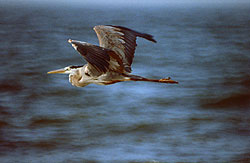 Birding, or bird watching, is an activity that can be done anywhere out of doors, or sometime indoors if one visits an aviary. Today more than forty-six million people in our country find pleasure in following and watching the antics of birds. They spend considerable amounts of their earnings and savings on books, attire, equipment, seed, suet and travel just to satisfy a desire to view an unusual pair of wings. But basically, bird watching is an inexpensive hobby because all that is required is a pair of binoculars and a field guide to the local birds. Perhaps this is the reason why birding has become such a popular pastime. Or philosophically, maybe we admire the freedom of birds and by watching them, try to absorb their liberty to quell the constraint and confusion in our lives. Roger Tory Peterson, the John James Audubon of our century, suggested the latter as his explanation for the explosion of human interest in birds when he said, “In a world that seems so very puzzling is it any wonder birds have such appeal? Birds are, perhaps, the most eloquent expression of reality.”
Birding, or bird watching, is an activity that can be done anywhere out of doors, or sometime indoors if one visits an aviary. Today more than forty-six million people in our country find pleasure in following and watching the antics of birds. They spend considerable amounts of their earnings and savings on books, attire, equipment, seed, suet and travel just to satisfy a desire to view an unusual pair of wings. But basically, bird watching is an inexpensive hobby because all that is required is a pair of binoculars and a field guide to the local birds. Perhaps this is the reason why birding has become such a popular pastime. Or philosophically, maybe we admire the freedom of birds and by watching them, try to absorb their liberty to quell the constraint and confusion in our lives. Roger Tory Peterson, the John James Audubon of our century, suggested the latter as his explanation for the explosion of human interest in birds when he said, “In a world that seems so very puzzling is it any wonder birds have such appeal? Birds are, perhaps, the most eloquent expression of reality.”
If the definition of a birdwatcher is a person who devotes serious time and effort to the study of birds and travels for the sake of observing birds, then I didn’t become a real birder until 1976. Prior to that, year as a student of biology I had had a few encounters with birds but none that could be construed as intentional bird watching. In fact, my earlier encounters were more like confrontations.
In 1976, I completed the requirements for a Ph. D. in marine ecology, moved to Alabama and accepted a faculty position in biology at The University of Alabama in Huntsville. That year I also met Dr. J. Milton Harris, who was deeply involved in the Alabama Ornithological Society and the Audubon chapter in North Alabama. Because of Milton, I had a chilling initiation into the realm of birding. He invited me to accompany him on the day designated as the 1976 Audubon National Christmas Bird Count. From about five o’clock in the morning until well after dark we trudged around Wheeler National Wildlife Refuge on a turbulent, breath-freezing gray day in the middle of December, observing and counting birds. Interestingly, the birds cooperated and I enjoyed the brisk, life-changing experience.
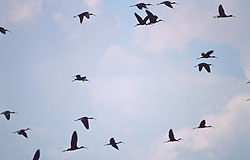 Today I consider myself a casual birdwatcher; my background in science and biology moves my curiosity more than just observing birds for their aesthetics. Yet, I derive pleasure and relaxation from watching birds and find them mystifying and intriguing. I’m awed by their energy, behavior and intelligence. Though, since 1976, I have taken few trips strictly for the purpose of observing birds, I always pack my binoculars and a field guide to the local birds whenever I travel. Whether my trips are for business or pleasure, I usually find some hours or days that I can devote to watching birds. Since the 1990s birding during my travels has even become more important, because my wife Marian, also an ardent bird-watcher, accompanies me on many of my trips. We have found that two pair of eyes scanning a forest, meadow, beach or barnyard can see more birds than one pair.
Today I consider myself a casual birdwatcher; my background in science and biology moves my curiosity more than just observing birds for their aesthetics. Yet, I derive pleasure and relaxation from watching birds and find them mystifying and intriguing. I’m awed by their energy, behavior and intelligence. Though, since 1976, I have taken few trips strictly for the purpose of observing birds, I always pack my binoculars and a field guide to the local birds whenever I travel. Whether my trips are for business or pleasure, I usually find some hours or days that I can devote to watching birds. Since the 1990s birding during my travels has even become more important, because my wife Marian, also an ardent bird-watcher, accompanies me on many of my trips. We have found that two pair of eyes scanning a forest, meadow, beach or barnyard can see more birds than one pair.
The chapters that follow recount some of the bird watching adventures that I have experienced along the paths I’ve traveled. A list of the common and scientific names of bird species I observed is included at the end of each chapter that describes my trips.
Excuse me, while I chase a few more wings.
TABLE OF CONTENTS
FLEDGING A BIRDER — Toledo, Ohio
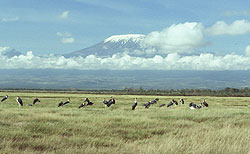 BIRDS IN THE EXTINCT BLACK SWAMP — Oregon, Ohio
BIRDS IN THE EXTINCT BLACK SWAMP — Oregon, Ohio
STARLINGS IN THE BELFRY — Norwich, Connecticut
A SWAN’S REVENGE — Niantic, Connecticut
BIRD IN A HOLE — Kauai, Hawaii
MOSQUITOES, SPACE SHUTTLES, AND SWEAT — Merritt Island, Florida
IT THINKS I’M ITS PARENT — Delafield, Wisconsin
BIRDING THE RIFT VALLEY — Kenya, East Africa
IN THE MIDDLE OF THE INDIAN OCEAN — Seychelle Islands, Africa
THE CORMORANT CONUNDRUM IN LAKE ERIE — West Sister Island, Ohio
IN SEARCH OF PIRATES’ PARROTS — Grand Cayman Island
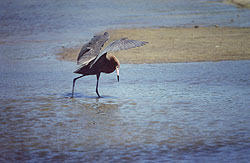 TROGONS, BECARDS AND OWLS IN NEED OF A SHAVE — Southeast Arizona
TROGONS, BECARDS AND OWLS IN NEED OF A SHAVE — Southeast Arizona
SKIMMING ALONG WITH BLACK SKIMMERS — Dauphin Island, Alabama
SAGA OF A FRIGATE BIRD NAMED ELVIS — Carrie Bow Cay, Belize
RAPTOR CENTER — Alsace, France
SYMBOLIC BIRD, THE STORK — Strasbourg, France
BIRDING AMONG GLACIAL GROOVES — Kelly’s Island, Ohio
HUMMERS, TOUCANS, BASKET WEAVERS AND FLYCATCHERS — Belize
A BIRD WATCHER’S SMORGASBORD — Skåne, Sweden
THE THREE AMIGOS — Owens Cross Roads, Alabama
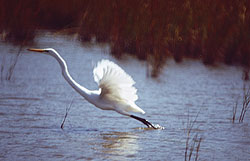 SANDHILL CRANES, DUCKS AND MORE — Wheeler National Wildlife Refuge, Alabama
SANDHILL CRANES, DUCKS AND MORE — Wheeler National Wildlife Refuge, Alabama
SHELL MOUNDS AND BEACH SAND — Dauphin Island, Alabama
SEA PARROTS AND OCEANIC RARITIES — Washington County, Maine
WRENSONG — Owens Cross Roads, Alabama
BIBLIOGRAPHY
